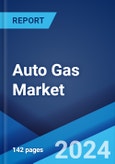Auto gas, also known as autogas or liquefied petroleum gas (LPG), is a clean-burning alternative fuel commonly used in internal combustion engines. It is composed of a mixture of propane and butane gases, which are derived from the refining of crude oil or natural gas processing. Auto gas is stored in pressurized tanks in a liquid state that is converted into vapor when it is released for combustion. It offers several advantages as a fuel for vehicles, such as it is a more environment-friendly option compared to traditional gasoline or diesel fuels. Furthermore, auto gas is cost-effective as it is generally priced lower than gasoline and diesel, making it an attractive choice for budget-conscious vehicle owners. Additionally, the maintenance costs associated with auto gas-powered vehicles tend to be lower compared to traditional internal combustion engines, as auto gas burns cleaner, leading to reduced engine wear and extended lifespan of engine components.
Auto Gas Market Trends:
One of the primary factors driving the market is the increasing awareness and concerns about environmental issues, such as air pollution and climate change. Auto gas is considered a cleaner-burning fuel compared to gasoline and diesel, as it emits fewer greenhouse gases, particulate matter, and toxic pollutants. Besides this, governments and environmental organizations are promoting the use of auto gas to reduce vehicular emissions and improve air quality. Additionally, auto gas is generally priced lower than traditional fuels like gasoline and diesel. This cost advantage and the lower maintenance costs associated with auto gas-powered vehicles makes auto gas an attractive option for vehicle owners. Other than this, the availability and accessibility of auto gas refueling infrastructure are key factors influencing its market growth. Expansion of refueling stations and the establishment of a robust distribution network is essential for the wider adoption of auto gas. Moreover, governments and private companies are investing in infrastructure development to ensure convenient refueling options for auto gas users. Besides this, the advancement of vehicle conversion technology has facilitated the adoption of auto gas. Furthermore, the availability of conversion kits and the expertise of skilled technicians are making it convenient for vehicle owners to switch to auto gas without significant modifications to their vehicles. On account of these factors, the market is expected to create a positive thrust in the coming years.Key Market Segmentation:
The publisher provides an analysis of the key trends in each segment of the global auto gas market, along with forecasts at the global, regional, and country levels from 2025-2033. Our report has categorized the market based on type and vehicle type.Type Insights:
- Propane
- Butane
- Others
Vehicle Type Insights:
- Passenger cars
- Commercial vehicles
Regional Insights:
- North America
- United States
- Canada
- Europe
- Germany
- France
- United Kingdom
- Italy
- Spain
- Russia
- Others
- Asia Pacific
- China
- Japan
- India
- South Korea
- Australia
- Indonesia
- Others
- Latin America
- Brazil
- Mexico
- Others
- Middle East and Africa
Competitive Landscape:
The report has also provided a comprehensive analysis of the competitive landscape in the global auto gas market. Detailed profiles of all major companies have been provided. Some of the companies covered include Aygaz A.S., BP plc, China Petroleum & Chemical Corporation (China Petrochemical Corporation), Flogas Britain Limited (DCC plc), Lange Gas, Likitgaz Dagitum ve Endustri Anonim Sirketi, Shell Plc, SHV Energy N.V., Total Energies SE, Westfalen, etc. Kindly note that this only represents a partial list of companies, and the complete list has been provided in the report.Key Questions Answered in This Report:
- How has the global auto gas market performed so far, and how will it perform in the coming years?
- What are the drivers, restraints, and opportunities in the global auto gas market?
- What is the impact of each driver, restraint, and opportunity on the global auto gas market?
- What are the key regional markets?
- Which countries represent the most attractive auto gas market?
- What is the breakup of the market based on the type?
- Which is the most attractive type in the auto gas market?
- What is the breakup of the market based on the vehicle type?
- Which is the most attractive vehicle type in the auto gas market?
- What is the competitive structure of the global auto gas market?
- Who are the key players/companies in the global auto gas market?
Table of Contents
Companies Mentioned
- Aygaz A.S.
- BP plc
- China Petroleum & Chemical Corporation (China Petrochemical Corporation)
- Flogas Britain Limited (DCC plc)
- Lange Gas
- Likitgaz Dagitum ve Endustri Anonim Sirketi
- Shell Plc
- SHV Energy N.V.
- Total Energies SE
- Westfalen
Methodology

LOADING...
Table Information
| Report Attribute | Details |
|---|---|
| No. of Pages | 148 |
| Published | March 2025 |
| Forecast Period | 2024 - 2033 |
| Estimated Market Value ( USD | $ 54.2 Billion |
| Forecasted Market Value ( USD | $ 80.9 Billion |
| Compound Annual Growth Rate | 4.6% |
| Regions Covered | Global |
| No. of Companies Mentioned | 10 |









